Understanding Force Kites: Their Mechanics and Uses
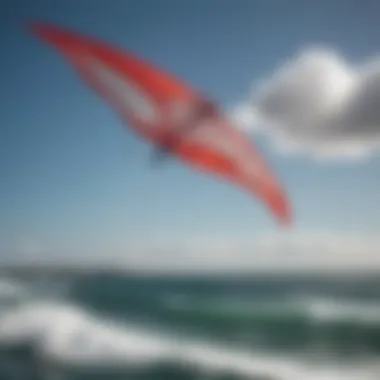
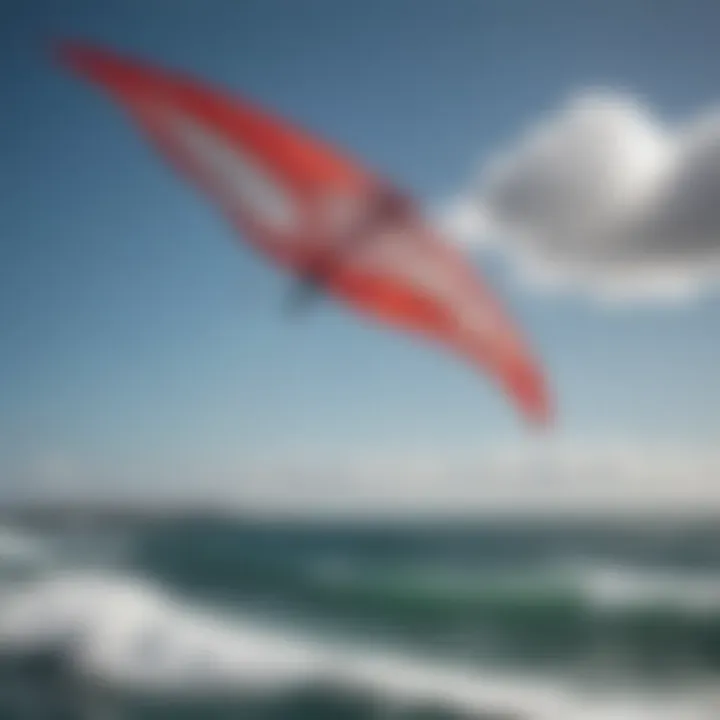
Intro
Force kites are fascinating devices that capture both the interest of aeronautical enthusiasts and the casual adventurer. Unlike traditional kites, which are often flown for mere enjoyment, force kites harness the wind to generate noticeable pull — making them suitable for a myriad of applications. Understanding the nuances of how these kites operate and their various uses can greatly enhance one's experience, whether for leisure or professional purposes.
In this section, we will unravel the foundational aspects of force kites, delving into their unique mechanics and the technology behind their design. Additionally, we will explore their practical applications across diverse fields, touching upon the significant advancements that have emerged in recent years. With safety practices and gear recommendations, this article serves as a thorough guide for everyone from novices to industry professionals.
Gear Recommendations
Choosing the right gear is pivotal when exploring the world of force kites, as it significantly influences performance and safety. Whether you're just starting out or looking to elevate your skills, the right equipment sets the stage for an enjoyable experience.
Essential Gear for Beginners
For beginners, selecting kites that are easy to handle is critical. One might consider the following items:
- Dual-Line Trainer Kites: These are lightweight, manageable kites that offer a gentle introduction to controlling a kite. Their user-friendliness aids in grasping the basic mechanics of tether management and wind navigation.
- Safety Harnesses: Even for novices, a harness is a worthwhile investment. It provides additional stability while allowing users to focus on learning maneuvering techniques.
- Kite Lines: Beginners should look for durable lines that can withstand occasional snags without breaking. A good rule of thumb is to go for lines that are at least 200 feet long to give ample room for practice.
Advanced Equipment for Professionals
As you delve deeper into kite flying or perhaps take on professional engagements, your gear needs to be more sophisticated. Some recommendations include:
- High-Aspect Ratio Kites: These kites are designed for speed and precision. They enhance performance by allowing more lift, ideal for skilled flyers looking to execute complex tricks.
- Customizable Control Bars: Advanced control systems can be adapted to the user's preference. This adjustment can drastically improve handling and response time, allowing for a tailored flying experience.
- Multi-Lined Kites: These kites equip experienced users with increased maneuverability and intense pull. The ability to control multiple lines enables more elaborate aerial displays.
Summary of Gear Considerations
In summary, selecting the appropriate gear can make a world of difference when learning about and using force kites. It’s paramount that beginners start with accessible equipment while professionals should gradually evolve their gear according to their experience level and specific needs. Understanding the mechanics and limits of your kite can enhance safety and enjoyment.
Techniques and Tips
To fully appreciate the thrill offered by force kites, it’s essential to hone your skills and follow safety measures rigorously. Below are some strategies to improve your kite flying and ensure an enjoyable experience:
Skill Improvement Strategies
- Practice Daily: Nothing beats repetition. Spend time in different wind conditions to understand how your kite reacts. This variance can offer invaluable insights.
- Join a Club: Engaging with fellow kite enthusiasts can prove to be incredibly beneficial. Clubs often share techniques and tips that could enhance your skills.
- Study Advanced Techniques: There are numerous resources online, such as forums on reddit.com, where you can learn tricks from seasoned flyers. Don’t hesitate to dive deep.
Safety Practices and Guidelines
- Know Your Surroundings: Before flying, always assess the surroundings for obstacles like trees or power lines. This foresight can prevent mishaps.
- Wear Protective Gear: Invest in safety gear such as helmets and gloves. Flying can be unpredictable; adequate safety measures are non-negotiable.
- Check Kite Equipment Regularly: Whether it’s lines fraying or hardware loosening, inspecting your gear after every few flights can avert potential accidents.
"Taking the necessary precautions and proper training can allow you to enjoy the incredible potential of force kites to the fullest extent."
By focusing on improving your skills and adhering to safety guidelines, you position yourself to not just fly kites but to truly master the art of kite flying.
Foreword to Force Kites
The realm of force kites offers a fascinating glimpse into the intersection of engineering and recreation. Understanding these kites is not just about appreciating a colorful spectacle in the sky; it involves diving into the mechanics that govern their flight and the diverse applications they find across various fields. Force kites are unique in their capability to harness wind energy and convert it into usable force, making them useful beyond mere amusement.
In this article, we will explore the different facets of force kites, from their aerodynamics to their evolution over time. We will also discuss how these kites are more than just toys for children in the park; they are complex devices used in professional competitions, educational settings, and even in power generation.
Let's begin by diving deeper into what exactly we mean by force kites and their significance.
Definition and Overview
Force kites, at their core, are specially designed kites that generate pull or force when maneuvered in the wind. Unlike traditional kites that simply glide and float with the air currents, force kites utilize advanced aerodynamic principles to create a substantial amount of lift and drag. This allows them to exert a pulling force, which can be beneficial in activities like kite surfing or even in towing small objects.
Typically, these kites are constructed from lightweight yet durable materials, such as ripstop nylon or polyester, which are capable of enduring the stresses of high-speed flight. The design of a force kite often includes features like multiple lines or control bridle systems, allowing the user to steer the kite effectively.
The main allure of force kites lies in their ability to provide a unique experience, blending the thrill of flying with the science of physics. Their applications range from recreational uses, such as kite flying events and sports, to educational projects aimed at teaching principles of flight and wind dynamics.
Historical Context and Evolution
The journey of force kites through time is quite remarkable. While kites date back thousands of years, force kites as we recognize them today began to materialize in the late 20th century. Early forms of the kite were used for military purposes in China and later for scientific experiments. However, it was in the 1970s and 1980s that innovations in materials and design began to redefine kites, leading to the emergence of force kites.
The introduction of nylon sails and stronger, lighter structural framework allowed for greater performance and control. As more enthusiasts entered the field, new designs evolved to cater to diverse interests, resulting in the wide variety of force kites we see today, from daily recreational models to highly specialized competition kites.
"Kites are not just playthings; they embody a blend of art and science, showcasing human ingenuity across cultures and ages."
The timeline tells us not just about the changes in materials and design, but also about the growing recognition of kites as serious instruments in various applications. Modern force kites are designed to tackle rigorous challenges, such as harnessing wind energy more efficiently while simultaneously offering a fun and engaging experience for users. This intricate evolution has led to a sophisticated interplay of mechanics and artistry, making force kites significant both historically and in contemporary contexts.
Mechanics of Force Kites
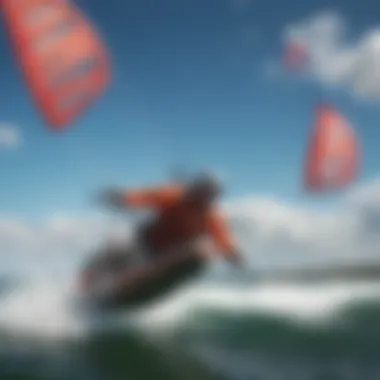
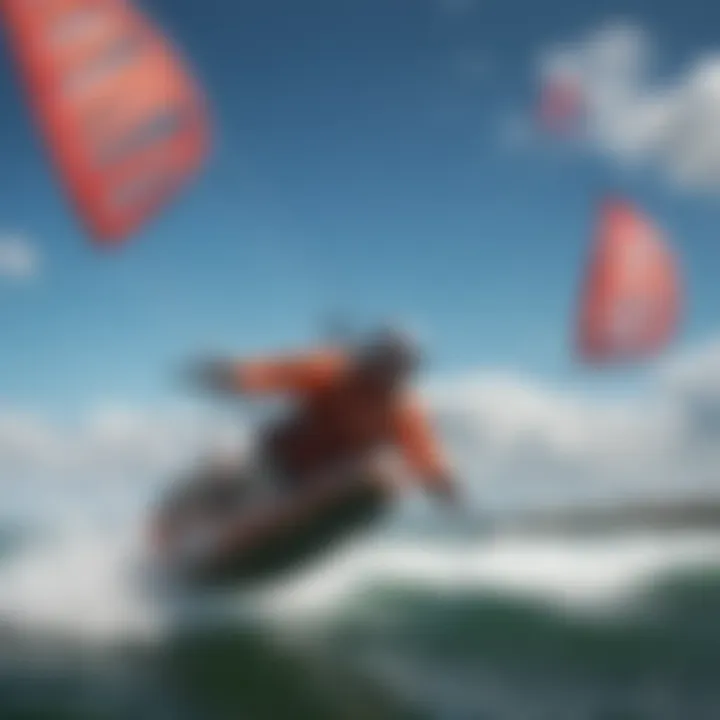
Understanding the mechanics of force kites is pivotal for anyone looking to harness their potential in various fields. The intricate dance of aerodynamic forces at play is essential for not only kite enthusiasts but also for those engaged in professional kite sports. Knowing how a force kite operates can enhance safety, boost performance, and enable a greater appreciation of its capabilities.
Basic Aerodynamics Principles
At its core, the mechanics of a force kite revolves around basic principles of aerodynamics. Lift, drag, weight, and thrust interplay to create the unique flying characteristics of these kites. A good way to think about lift is to imagine wind pushing against the kite’s surface. This force acts in an upward direction, counteracting gravity’s downward pull.
Moreover, understanding drag is equally crucial. Drag, which is the resistance an object encounters while moving through the air, can slow down the kite and affect its overall stability. By balancing lift and drag, one can optimize kite performance, ensuring it flies at a steady altitude while maneuvering gracefully in the wind.
Some factors influencing these aerodynamic principles include:
- Angle of Attack: This is the angle between the kite’s chord line and the oncoming wind. Adjusting this can significantly affect lift.
- Wind Speed: Higher wind speeds usually increase lift but may also lead to excessive drag. Finding the sweet spot is essential.
- Shape and Size: The design of the kite impacts its aerodynamic efficiency. Wider kites may catch more wind but could also face greater drag.
Understanding the intricate relationship between these elements helps kite flyers make informed decisions that can enhance their flying experience.
Design Elements of Force Kites
Force kites come in a diverse array of designs, each tailored for specific purposes and environments. When crafting a kite, designers consider numerous elements that contribute to its performance.
- Wing Shape: Different shapes can offer varying levels of maneuverability and speed. For example, delta-shaped kites often provide excellent stability, while parafoils are flexible and can adapt to changing winds.
- Frame Structure: The frame can be designed using materials such as fiberglass or carbon fiber, each providing different strength-to-weight ratios which influence the kite’s resilience against forces.
- Sail Tension: Proper tension on the sail is crucial. Too loose, and the kite could flounder; too tight, and it may become rigid, reducing its agility.
Designers often blend aesthetics with functionality, and the final result is a kite that is as much a work of art as it is a tool for performance.
Materials Used in Construction
The choice of materials in force kite construction plays a significant role in determining its performance characteristics. The lightweight, strong materials not only enhance the kite's durability but also its responsiveness to wind conditions.
Some common materials include:
- Ripstop Nylon: Known for its durability, this fabric is a staple in kite making. It’s lightweight yet strong, which allows it to withstand the stresses of flying.
- Mylar: Sometimes used for its reflective properties, Mylar can aid in visibility, especially for sport kites. While not as common for regular recreational kites, it finds its niche in competitive circles.
- Carbon Fiber: This material is prized for its strength and lightness in frames. A kite made with carbon fiber typically has enhanced performance but at a higher price point.
Using the right materials can drastically influence not only the flying experience but also how well the kite holds up against various weather conditions and stresses. Designing a kite with the proper components paves the way for successful launches and smooth flights.
"Mastering the dynamics of force kites isn't just about flying; it’s about understanding the forces that keep you afloat."
Applications of Force Kites
Force kites serve a multitude of purposes, stretching far beyond mere amusement for enthusiasts. Their applications span recreational activities, educational settings, and professional contexts, highlighting their versatility and importance in both leisure and serious endeavors. Adopting a force kite means engaging with an array of activities that not only entertain but also educate and inspire. The relevance of their applications will unfold in the subsequent sections, each exploring a distinct aspect that showcases the benefits and special considerations associated with these fascinating devices.
Recreational Use
When it comes to fun in the great outdoors, force kites take pleasure to new heights. Unlike simple decorative kites, these dynamic creations harness the wind's energy for exhilarating experiences. Families flock to beaches and parks, guiding colorful kites in choreographed dances against the backdrop of a blue sky. Whether it’s a lazy Sunday afternoon or a spirited weekend gathering, the joy of wielding a force kite transforms the mundane into memorable adventures.
"In the right conditions, a force kite can become an extension of your own spirit; you feel every gust and pull, and your body instinctively works in tandem with it."
- Benefits of Recreational Use:
- Physical Fitness: Launching and maneuvering a force kite builds core muscles and improves balance.
- Mental Well-Being: Being outdoors while engaged in an active pastime contributes positively to mental health.
- Social Connections: Kite flying creates bonds among participants; communities often come together for organized events.
Recreational applications of force kites are vital in instilling an appreciation for outdoor activities among various age groups. They encourage adventure, teamwork, and a deeper connection to nature, making them relevant in today’s increasingly digital landscape.
Educational Purposes
Bringing the principles of physics to life, force kites play a pivotal role in education. Students from various disciplines can observe the laws of aerodynamics in action. Maker spaces and STEM programs often use force kites to facilitate hands-on learning experiences that bridge theory and practice.
Teachers utilize kites as tangible tools to illustrate complex concepts such as lift, drag, and thrust.
- Key Educational Benefits:
- Interactive Learning: Engaging students in building and flying kites fosters a deeper understanding of scientific principles.
- Critical Thinking: Students must utilize problem-solving skills to optimize their kite designs for better performance.
- Collaboration: Group projects centered around kite-building encourage teamwork and communication.
As students engage in these activities, they cultivate skills that will serve them well in numerous fields. The blend of play and education provided by force kites enhances learning experiences, making science concepts less abstract and more relatable.
Professional and Competitive Use
In the professional realm, force kites find their place not just in sports but also in various industries. The arena of competitive kite flying has burgeoned, with international events showcasing skilled competitors who choreograph stunning aerial displays. Kite surfing and landboarding have further cemented the appeal of force kites in the sporting culture.
- Highlights of Professional Use:
- Kite Surfers: Harness the wind to ride waves, blending the art of kiting with extreme water sports.
- Environmental Monitoring: Researchers deploy kites for aerial surveys to study ecosystems or pollutants in a cost-effective manner.
- Marketing and Promotions: Brands are increasingly using force kites in promotional activities to capture audience attention in a unique way.


Understanding the professional applications of force kites opens doors to potential avenues for business, research, and sport. The integration of innovation and competition often drives advancements in kite technology and techniques, positioning them as a significant player in today's active and recreational culture.
Safety Considerations
Safety is paramount when engaging with force kites, a fact that should not be taken lightly. Whether you’re a seasoned professional or a novice just starting out, understanding the safety aspects involved can make a world of difference. Safety considerations involve assessing risks, being aware of environmental conditions, and applying best practices during operation to minimize accidents and injuries. Ensuring safety not only protects individuals but also enhances the overall enjoyment and longevity of the activity. When everyone plays by the rules, the thrill of flying kites transforms into a safe and exhilarating experience for all involved.
Risk Assessment
Conducting a risk assessment when flying force kites is essential. This means evaluating both the environment and personal capabilities before taking to the skies. Start by examining weather conditions: strong winds, rain, and lightning pose serious threats. For instance, if wind gusts surpass the recommended range for your specific kite, that’s a clear sign to play it safe.
Beyond nature’s temper, consider the area around you. Flying kites in crowded parks or near power lines increases the risk of accidents. Always look around and make sure the airspace is clear. Not only about the physical surroundings, assess your own skill level. If you’re new to this, it may be wise to practice in a more controlled environment before venturing into more challenging locations.
"A stitch in time saves nine." This idiom applies here—taking the time to assess potential hazards can save you from serious issues later on.
Best Practices for Safe Operation
To operate force kites safely, implementing best practices becomes crucial. Here are some effective strategies to keep in mind:
- Check Equipment Regularly: Before each flight, inspect the kite for any wear or damage. Look at the frame, lines, and any accessories. A small tear might seem trivial but can lead to catastrophic failure mid-flight.
- Follow Manufacturer Guidelines: Each kite comes with its own set of instructions. Adhering to the recommendations can prevent mishaps. This includes weight limits, recommended wind conditions, and proper launching techniques.
- Use Proper Equipment: Make sure that you use a suitable harness and lines. Opt for high-quality materials that are designed for kites to avoid breakage during flight.
- Communicate with Others: If flying with a group, establish clear signals or calls to inform each other of any changes, like unexpected drafts. Clear communication can go a long way in preventing accidents.
- Have a Landing Plan: Know when and how you will bring your kite down. This is especially vital during unexpected changes in weather. Having a strategy can help you stay calm and collected.
By paying close attention to these practices and being mindful of your surroundings, you can enjoy the thrill of force kites while significantly reducing the chance of accidents. Safety should never be an afterthought—it should be ingrained in your kite-flying experience.
Technological Advancements
In the realm of force kites, the role of technological advancements cannot be overstated. These innovations reshape how enthusiasts and professionals utilize kites, streamlining their experiences while enhancing performance. The importance of integrating modern technologies into the design and functionality of force kites is evident across various applications, from recreational use to competitive events.
Innovative Materials and Designs
The materials used in force kites have evolved dramatically over the years. Traditional kites often relied on cotton, paper, or basic plastic. Nowadays, kite manufacturers are harnessing cutting-edge materials like ripstop nylon and carbon fiber to improve durability and performance. These lightweight options do wonders in reducing drag while increasing structural integrity.
Features like reinforced seams and advanced aerodynamic shapes are layered into the designs, enhancing maneuverability and lift. For instance, some force kites sport a unique, tapered leading edge, which allows them to cut through the air more efficiently, providing those excited bursts of power that kiting enthusiasts crave.
Furthermore, designers are experimenting with hybrid configurations, which combine different materials to leverage their respective strengths. This leads to kites that not only withstand the rigors of nature but also deliver exceptional flying experiences, whether you're soaring at a beach or racing across a soccer field.
Integration of Smart Technologies
As technology continues to break new ground, the integration of smart technologies into the force kite arena is gaining momentum. This leap towards digitization opens up new horizons for users. Consider kites equipped with GPS tracking, which allow users to monitor their flight path and speed through a connected app. Such features promote not only performance analysis but also safety, as users can recreate their flight adventures or pinpoint where their kite landed in case of an unexpected crash.
Moreover, some kites now incorporate sensors that can detect wind speed and direction, providing real-time feedback to the pilot. This ability transforms the user experience—helping them make quick adjustments to their technique or even enabling automated control to optimize performance.
By integrating smart technologies, force kites become more than just recreational toys. They turn into intricate systems that can comply with the kite's environment, aiding in athletic training or even scientific research regarding aerodynamics and environmental conditions.
"Technology in kites is not just an upgrade; it’s a complete overhaul of what we understand about flying and performance."
In summary, the importance of technological advancements in the force kite domain is all-encompassing. From using innovative materials that boost performance to embedding smart technologies that enhance user interaction, these strides present a plethora of opportunities for athletes, instructors, and outdoor enthusiasts alike. Keeping abreast of these trends not only elevates individual experiences but also pushes the boundaries of what can be achieved with kite sports.
Environmental Impact
The environmental considerations of force kites have gained prominence as their popularity soars among outdoor enthusiasts, athletes, and educators. Understanding the impact of kite production and usage on our surroundings is crucial for fostering sustainable practices in the field. This discussion not only highlights the benefits of adopting eco-friendly methods in kite manufacturing but also addresses potential drawbacks on local ecosystems.
Sustainability in Kite Manufacturing
Kite manufacturing can take a significant toll on the environment if traditional production processes are employed. However, innovative approaches are emerging that prioritize sustainability. Manufacturers are now exploring a variety of eco-friendly materials and practices that help mitigate environmental damage. For instance, using recycled plastics and biodegradable fabrics allows production to become more sustainable.
- Use of Recycled Materials: Some companies are turning used plastic into durable kite fabric. This helps reduce plastic waste and can lower overall production costs.
- Natural Fibers: Integrating materials like bamboo and cotton not only enhances the kite's performance but also decreases reliance on synthetic materials.
- Eco-conscious Processes: Implementing lower-energy manufacturing techniques minimizes the carbon footprint associated with production.
Moreover, many manufacturers are incorporating lifecycle assessments to evaluate the environmental impact from cradle to grave. Adopting these sustainable practices benefits not just the planet, but also enhances brand reputation among informed consumers who care about eco-friendliness.
"Our focus is on creating kites that are not only fun to fly but also mindful of Mother Earth."
— A leading force kite manufacturer
Effects on Wildlife and Ecosystems
While the thrill of flying force kites captivates many, it's crucial to remain aware of potential consequences on wildlife and ecosystems. As kites soar in the sky, they can intersect with the habitats of various birds and other wildlife. It’s imperative to recognize how these activities might disturb natural settings.
- Entity Interference: In areas where force kiting is popular, flying near nesting birds can disturb their breeding process. This can lead to abandoned nests and, consequently, decline in bird populations.
- Damage to Habitats: The physical presence of heavy kites or tangled lines can inadvertently affect local flora, especially in delicate ecosystems where damage can result in habitat loss.
- Noise and Disturbance: The sound generated by kites, particularly during competitive events, can create stress among wildlife. The presence of groups of kiting enthusiasts can further add to disturbances.
To minimize ecological impacts, practitioners should
- observe specific guidelines regarding flying locations,
- respect natural habitats, and
- reinforce behaviors that promote environmental stewardship.
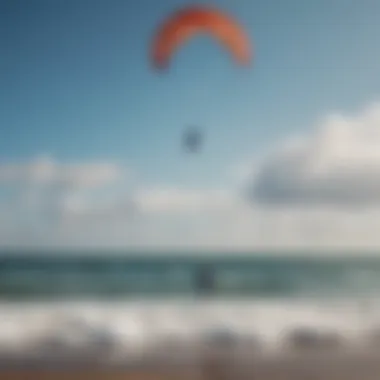

In sum, the environmental impact of force kites encompasses both the opportunities for sustainable manufacturing and the challenges presented to local wildlife. Careful consideration of these elements fosters a more harmonious relationship between human activity and nature.
Comparative Analysis
In a comprehensive discourse on force kites, Comparative Analysis holds a pivotal role. This segment allows us to understand how force kites stack up against traditional kites, as well as their influence in various sports. By exploring these factors, it becomes evident how the unique features and functionalities of force kites contribute to their growing popularity among athletes and outdoor enthusiasts alike. This analysis not only sheds light on the differences and similarities but also emphasizes the importance of understanding kites in distinct contexts—be it recreation or professional sports.
Force Kites vs. Traditional Kites
When taking a closer look at force kites and traditional kites, several key distinctions arise. Firstly, force kites are designed to harness wind power in a manner that maximizes lift and pull. They are built with a specific focus on aerodynamic stability, allowing them to operate efficiently in a variety of conditions. In contrast, traditional kites often prioritize visual aesthetics and may not perform as well when faced with changing wind patterns.
Key differences include:
- Design and Structure: Force kites often feature a wider profile, which can create greater surface area to catch the wind, whereas traditional kites tend to have more simplistic designs.
- Material Usage: The materials used in force kite construction, often advanced composites or ultra-light fabrics, are specifically chosen for enhanced performance. Traditional kites might rely on less innovative, more rigid materials that do not offer the same level of adaptability.
- Flight Dynamics: Force kites can maintain sustained power and provide a steady pull, making them ideal for activities such as kiteboarding or power kiting. Traditional kites, while they can be fun for leisure purposes, may lack the same level of control and responsiveness in dynamic environments.
"Understanding the core differences between force kites and traditional kites allows enthusiasts to make informed choices based on their objectives and the kind of experience they seek."
These distinctions have real-world implications for individuals looking to engage in various activities. For practitioners of extreme sports or those involved in professional settings, the advantages of force kites can lead to improved performance and an overall better experience. Meanwhile, traditional kites continue to serve their purpose in more casual settings, where aesthetics may take precedence over performance.
Force Kites in Different Sports
Force kites have carved out specific niches in numerous sports, each presenting unique challenges and requirements. Kite sports encompass a wide array of activities, such as kite surfing, land kiting, and snow kiting. In each of these realms, the specific characteristics of force kites shine through, enabling participants to harness wind power effectively.
- Kite Surfing: Here, force kites are essential. Riders utilize large, powerful kites to catch wind and propel themselves over water. The size and design of force kites make them suitable for lifting the rider into the air or accelerating them across waves, contributing both speed and agility that is critical in competitive environments.
- Land Kiting: In this domain, force kites take on a different form. Kites can be attached to vehicles like buggies or to snowboard-like boards for off-road enjoyment. The power generated by force kites allows for thrilling speeds and impressive maneuvers, capturing the adrenaline rush that enthusiasts seek.
- Snow Kiting: When the snow blankets the ground, force kites adaptations take center stage. Riders use these kites to skim across open fields or climb hills while feeling the wind in their face. The versatility of force kites in holding power, even in winter conditions, demonstrates their adaptability, which cannot be said for every traditional kite type in this environment.
The use of force kites in these varied sports not only enhances performance but also elevates the overall experience. They allow athletes to push their limits, whether it's soaring high above the water or racing across snowy expanses.
User Experience
User experience plays a critical role in how individuals engage with force kites, encompassing a broad spectrum of interactions that lead to satisfaction or frustration. In the realm of kiting, factors such as ease of use, functionality, and user feedback shape the overall experience, whether for hobbyists, athletes, or educators. A deep understanding of these experiences not only enhances enjoyment but also promotes safety and prolongs the lifespan of the kite and associated equipment.
Common Challenges and Solutions
Navigating the world of force kites isn't without its hurdles. Common challenges include:
- Wind Variation: Different wind conditions can either uplift or downplay the performance of the kite. Unexpected gusts may lead to difficulty in controlling the kite.
- Tangle Troubles: Lines may often get tangled, causing frustration or even damaging the kite.
- Learning Curve: New users may find it daunting to learn how to launch, control, and land a force kite.
- Material Durability: Force kites are subject to wear and tear over time, especially with frequent use.
- Solution: Regularly check wind forecasts and experiment in varied conditions to better understand how your kite responds.
- Solution: Practice proper line management and use a winder to keep lines organized when not in use.
- Solution: Joining a local kite club or participating in workshops can provide valuable hands-on experience and mentorship.
- Solution: Regularly inspect your kite for signs of damage or wear and replace parts as needed to extend longevity.
Community Insights and Feedback
Feedback from the kite flying community often highlights shared experiences, tips, and innovations that can enhance the user experience. Community platforms like Reddit and Facebook host groups where enthusiasts discuss their experiences:
- Peer Support: Users frequently report that connecting with fellow kite flyers provides both motivation and insight.
- Innovative Tips: From personal setup hacks to modified strategies for flying in different weather, the community shares vast knowledge.
"There’s nothing quite like the sense of accomplishment you feel after a successful launch, especially with support from friends who are as passionate as you are!"
- Event Participation: Engaging in local or international kite festivals opens the door to networking and learning, where community members can showcase their kites and learn from one another.
In summary, a comprehensive understanding of user experience in force kites showcases the importance of both connection and continuous learning within the community. Addressing common challenges and leveraging insights from fellow enthusiasts can lead to a more rewarding and enriching kiting experience.
Future of Force Kites
The future of force kites is a fascinating topic, especially as various advances in technology and societal trends constantly reshape the landscape in which these kites operate. Understanding this future is essential not only for enthusiasts and athletes but also for manufacturers and educators involved in this vibrant field. Force kites are increasingly finding their place beyond mere recreational tools—they are becoming significant in various applications like environmental monitoring and even urban energy generation. The shift in focus towards sustainability and innovative design suggests that we are just at the tip of the iceberg regarding what these kites can achieve.
Predicted Trends in Technology
With technology racing forward, force kites are expected to undergo several transformations. Here are some noteworthy trends to watch:
- Smart Kiting: Expect to see force kites embedded with sensors that can capture data about wind patterns and environmental conditions. This information could be invaluable for research and educational purposes.
- Advanced Materials: Innovations in materials science may lead to lightweight yet durable fabrics allowing for greater performance. For instance, using nanotechnology could lead to kites that can withstand harsher weather conditions without compromising on maneuverability.
- Integrated Power Sources: As renewable energy continues to be a priority, the integration of small-scale power generation with force kites might see them being used not only for recreation but also for harvesting wind energy efficiently.
- Improved Aerodynamic Designs: With computational fluid dynamics (CFD) tools becoming more accessible, designers will likely experiment with more complex shapes and structures that enhance the aerodynamics of kites, resulting in improved lift and control.
"Innovation is key in keeping the legacy of force kites alive and thriving, making them relevant in today’s fast-evolving world."
Potential Markets and Opportunities
As the world pivots toward eco-friendliness and innovation, several emerging markets and opportunities open in the force kite sector. Considering the following:
- Education and STEAM Programs: Schools may incorporate force kites into science, technology, engineering, arts, and mathematics curricula, providing students with practical applications of physics and engineering principles.
- Environmental Research: The use of force kites equipped with sensors for data collection in remote or challenging areas presents a niche market for researchers and environmentalists looking to monitor climate change and wildlife without intrusive methods.
- Sporting Events: A growing interest in extreme sports and competitive kiting means opportunities to organize events, competitions, or workshops centered around force kites could flourish. Local community sports programs might find force kites as an engaging way to attract athletes.
- Tourism and Adventure: Regions with favorable wind conditions could develop tourism packages that include force kite experiences, targeting adventure-seeking travelers looking for something different.
The future of force kites looks promising. Whether you’re a hobbyist, instructor, or professional, understanding these upcoming trends and potential markets can help you stay ahead in the exciting world of force kites.













